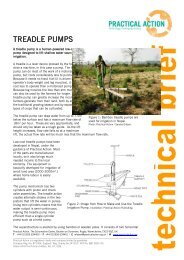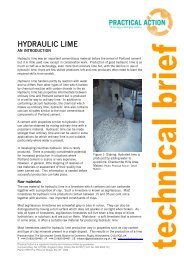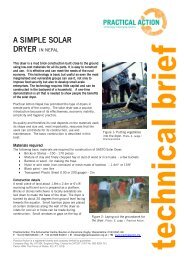Rainwater Harvesting
Rainwater harvesting - Worldwide Helpers
Rainwater harvesting - Worldwide Helpers
Create successful ePaper yourself
Turn your PDF publications into a flip-book with our unique Google optimized e-Paper software.
<strong>Rainwater</strong> harvesting<br />
Practical Action<br />
tank inlet, and then replaced again once the initial first flush has been diverted. This method<br />
has obvious drawbacks because there has to be a person present who will remember to move<br />
the pipe.<br />
Other systems use tipping gutters to achieve the same purpose. The most common system<br />
(as shown in Figure 7a) uses a bucket which accepts the first flush and the weight of this<br />
water off-balances a tipping gutter which then diverts the water back into the tank.<br />
The bucket then empties slowly through a small-bore pipe and automatically resets. The<br />
process will repeat itself from time to time if the rain continues to fall, which can be a<br />
problem where water is really at a premium. In this case a tap can be fitted to the bucket<br />
and will be operated manually. The quantity of water that is flushed is dependent on the<br />
force required to lift the guttering. This can be adjusted to suit the needs of the user.<br />
Figure 7b: Floating ball first flush system<br />
Another system relies on a floating ball<br />
that forms a seal once sufficient water has<br />
been diverted (see Figure 7b). The seal is<br />
made as the ball rises into the apex of an<br />
inverted cone. The ball seals the top of<br />
the ‘waste’ water chamber and the diverted<br />
water is slowly released, as with the bucket<br />
system above, through a small bore pipe.<br />
Again, the alternative is to use a tap. In<br />
some systems (notably one factory<br />
manufactured system from Australia) the<br />
top receiving chamber is designed such<br />
that a vortex is formed and any particles in<br />
the water are drawn down into the base of<br />
the vortex while only clean water passes<br />
into the storage tank. The ‘waste’ water<br />
can be used for irrigating garden plants or<br />
other suitable application. The debris has<br />
to be removed from the lower chamber<br />
occasionally.<br />
Although the more sophisticated methods provide a much more elegant means of rejecting<br />
the first flush water, practitioners often recommend that very simple, easily maintained<br />
systems be used, as these are more likely to be repaired if failure occurs.<br />
Filtration systems and settling tanks<br />
Again, there are a wide variety of systems available<br />
for treating water before, during, and after storage.<br />
The level of sophistication also varies from<br />
extremely high-tech to very rudimentary. A German<br />
company, WISY, have developed an ingenious<br />
filter which fits into a vertical downpipe and acts<br />
as both filter and first-flush system. The filter<br />
(Figure 8) cleverly takes in water through a very<br />
fine (~0.20mm) mesh while allowing silt and<br />
debris to continue down the pipe. The efficiency of<br />
the filter is over 90%. This filter is commonly used<br />
in European systems.<br />
The simple trash rack has been used in some<br />
systems but this type of filter has a number of<br />
associated problems: firstly it only removes large<br />
debris; and secondly the rack can become clogged<br />
easily and requires regular cleaning.<br />
6<br />
Figure 8 : the WISY filter (downpipe and<br />
high-capacity below ground versions)<br />
Source: WISY Catalogue





